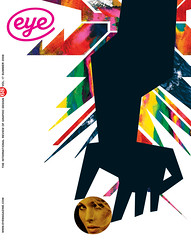Summer 2008
Pedro Inoue
Who cares about graphic design history?

Pedro Inoue comes from Sao Paulo. Having dropped out of studies in Brazil, he would say he has ‘a BA from Barnbrook Design, 2001-07’.
Q1. What do you think is meant by the canon of graphic design history? Do you ever think about it, or buy design history publications?
A1. For me El Lissitzky’s For the Voice, the punk movement and the digital shift in the profession are very important moments that you could call the canon of graphic design history. Coming from a country – Brazil – whose design history is not very well detailed and studied like in Europe, I have another perspective to add. I think design history is deeply linked with local culture, so what might be utterly important for my design might be completely useless for someone else’s, and vice versa. As for design history publications, I am interested but have never found myself buying one. I have bought books on a particular time in design history such as punk, though. When I left in 2001, there were only a couple of Brazilian design histories. Settling back there today, I can see many more publications, schools and people writing and researching Brazilian design.
Q2. Does design history have relevance to your design practice?
A2. It does, for several reasons. It inspires me and shows which paths were taken and why. It also reminds me that graphic design history is deeply connected with world history and all events of its time. Almost as a visual witness, a visual memory.
Q3. Where did you learn about design history (if at all)?
A3. I learned very little about design history in university. Mostly I’ve taught myself, from books on particular moments, rather than the ‘whole’ history. A lot of it I’ve learned from work colleagues.
Q4. Does history have any relevance to the new technology and techniques you’ve had to master in your work?
A4. Yes, especially in typography. You could say that the technology changes but the printed word stays the same. The same rules apply, and in order to bend these rules, one must know how they work.
Q5. If you were in charge of a design education programme, what aspects of design history (if any) would you teach to your students?
A5. I’d focus on one event in world history and its consequences and responses in design. I believe it is utterly important to study design as a visual response to history in all spectres.
Top: Falluja, Lambda print, 841 x 1253mm. Personal project designed by Pedro Inoue, 2007, named after the city in Iraq that was carpet-bombed in 2003. Inoue ‘flooded the letters with arms and fashion logos, camouflaging the significance of the word by over-decorating, over-exposing the glossiness into a beautiful hell.’
First published in Eye no. 68 vol. 17 2008
Eye is the world’s most beautiful and collectable graphic design journal, published quarterly for professional designers, students and anyone interested in critical, informed writing about graphic design and visual culture. It is available from all good design bookshops and online at the Eye shop, where you can buy subscriptions and single issues.

